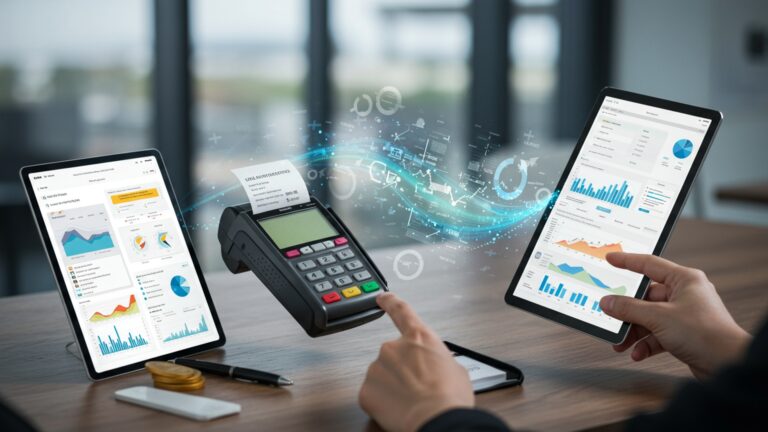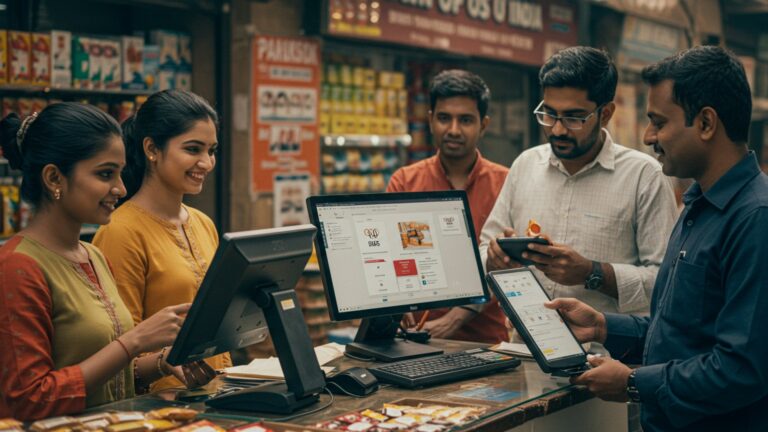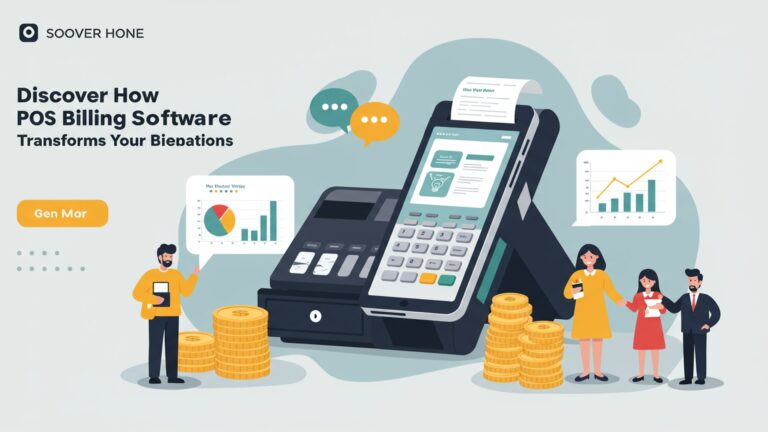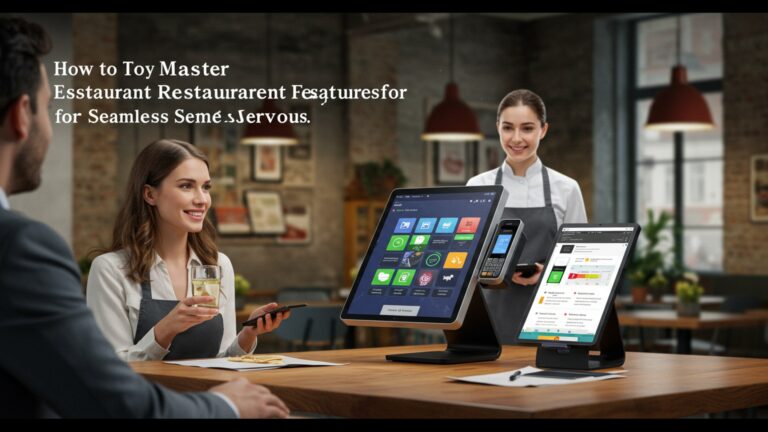Master Restaurant POS Software Essential Features to Boost Your Operations
In today’s dynamic culinary landscape, a robust restaurant POS software transcends mere transaction processing, becoming the operational backbone that empowers growth and efficiency. Modern systems integrate seamlessly across front-of-house, back-of-house. customer engagement, automating crucial tasks from real-time inventory management and staff scheduling to sophisticated table management and integrated online ordering platforms. Leveraging advanced features like QR code menu access and AI-driven sales analytics, top-tier POS solutions deliver actionable insights, optimize workflows. enhance the guest experience, moving beyond basic order entry to truly elevate a restaurant’s operational intelligence and profitability in a competitive market.

Understanding the Core: What is Restaurant POS Software?
In today’s fast-paced culinary world, a robust Point-of-Sale (POS) system is no longer a luxury but a fundamental necessity for any successful restaurant. At its core, restaurant POS software is a sophisticated system designed to manage all aspects of a restaurant’s operations, from taking orders and processing payments to tracking inventory and managing staff. Unlike generic retail POS systems, restaurant POS software is specifically tailored to the unique demands of food service, handling everything from table management and kitchen communication to ingredient tracking and recipe costing.
Think of it as the central nervous system of your establishment, integrating various functions into one cohesive platform. A well-implemented system can dramatically improve efficiency, reduce errors. provide invaluable insights into your business’s performance. For instance, a quick-service restaurant might prioritize speed and accuracy at the counter, while a fine-dining establishment might focus on seamless table service and reservation management. The right restaurant POS software adapts to these diverse needs.
Streamlining Order Management: The Heart of Your Operations
Efficient order management is paramount in the restaurant industry. Modern restaurant POS software excels in this area, transforming how orders are taken, processed. fulfilled. This feature set ensures accuracy and speed, directly impacting customer satisfaction and table turnover.
- Intuitive Order Entry
- Kitchen Display Systems (KDS)
- Table Management
- Order Customization and Modifiers
Servers can quickly take orders using touchscreens or handheld devices, customizing dishes, adding modifiers (e. g. , “no onions,” “extra cheese”). applying special requests with ease. This reduces manual errors and speeds up the ordering process.
A KDS is a digital screen in the kitchen that displays incoming orders from the POS. It replaces traditional paper tickets, improving communication, reducing miscommunications. allowing kitchen staff to prioritize orders, track preparation times. mark items as complete. This significantly enhances kitchen efficiency and order accuracy.
Advanced POS systems include visual table layouts, allowing hosts and servers to manage reservations, assign tables, split or combine tables. track the status of each table (e. g. , seated, ordered, eating, paid). This optimizes seating capacity and improves service flow.
The ability to easily add, remove, or modify ingredients is crucial. For example, a customer might request “gluten-free bun” or “sauce on the side.” The POS ensures these details are accurately communicated to the kitchen.
According to a study by Toast, restaurants using integrated KDS reported an average 3-minute reduction in ticket times, highlighting the tangible benefits of this feature.
Inventory Control: Reducing Waste and Optimizing Stock
Food cost is one of the largest expenses for any restaurant. Effective inventory management through restaurant POS software is critical for controlling these costs, minimizing waste. ensuring you never run out of popular items.
- Real-time Stock Tracking
- Recipe Management
- Supplier Management and Purchase Orders
- Waste Tracking
- Variance Reporting
The system automatically deducts ingredients from inventory as dishes are sold. This provides an accurate, up-to-the-minute view of stock levels for individual ingredients and menu items.
Inputting recipes into the POS allows for precise portion control and accurate costing. When a dish is ordered, the system knows exactly which ingredients and how much of each to deduct from inventory.
Generate purchase orders directly from the POS based on current stock levels and sales data. Manage supplier data, track delivery schedules. compare pricing to optimize purchasing decisions.
Easily record spoiled, dropped, or wasted items. This data is crucial for identifying problem areas, training staff. making adjustments to purchasing or preparation processes.
Compare theoretical inventory (based on sales) with actual physical inventory. Significant variances can indicate issues like theft, incorrect portioning, or poor receiving practices.
For example, a restaurant manager using their restaurant POS software can quickly identify that their avocado stock is consistently low by Thursday, prompting them to adjust their ordering schedule or supplier to meet weekend demand without overstocking. This proactive approach saves money and prevents customer disappointment.
Payment Processing: Fast, Secure. Flexible Transactions
In today’s diverse payment landscape, a flexible and secure payment processing system is non-negotiable. Modern restaurant POS software supports a wide array of payment options, catering to customer preferences and ensuring seamless transactions.
- Multiple Payment Methods
- EMV Compliance
- PCI DSS Compliance
- Integrated Payment Terminals
- Offline Mode
Accept credit/debit cards (Visa, Mastercard, Amex, Discover), mobile payments (Apple Pay, Google Pay), contactless payments (NFC), gift cards. even split payments between multiple guests or payment types.
Ensure your system is EMV (Europay, MasterCard. Visa) compliant to process chip card transactions securely, protecting your business from chargeback liability due to fraudulent transactions.
Adherence to Payment Card Industry Data Security Standard (PCI DSS) is vital for protecting sensitive customer payment data, reducing the risk of data breaches.
Seamless integration means no manual entry of amounts, reducing errors and speeding up transactions. Tips can be easily added. receipts can be printed or emailed.
Some advanced POS systems offer an offline mode, allowing transactions to be recorded and processed once internet connectivity is restored, preventing disruptions during outages.
A case in point: during a busy Friday night, a restaurant experiences a temporary internet outage. Thanks to its modern restaurant POS software with offline capabilities, transactions continue to be processed, ensuring no loss of sales or customer frustration, with all data syncing automatically once the connection is restored.
Staff Management: Empowering Your Team and Boosting Productivity
Your staff are the backbone of your restaurant. Effective staff management features within restaurant POS software streamline operations, improve team communication. help you make data-driven decisions about your workforce.
- Time and Attendance Tracking
- Role-Based Access Control
- Performance Tracking
- Scheduling Integration
Staff can clock in and out directly through the POS, accurately recording work hours. This data integrates with payroll systems, simplifying wage calculation and reducing administrative overhead.
Assign different permission levels based on staff roles (e. g. , server, manager, bartender). This ensures that employees only access the features and data relevant to their job, enhancing security and preventing unauthorized actions. For instance, only a manager might be able to process refunds or modify prices.
Monitor individual server performance, including sales per hour, average check size. tip percentages. This data can be used for coaching, incentives. scheduling optimization.
Some systems offer integrated scheduling tools, allowing managers to create and distribute schedules, manage shift swaps. communicate with staff directly through the platform.
By leveraging these features, a manager can quickly identify their top-performing servers and schedule them during peak hours, or provide additional training to those who might need it, ultimately boosting overall team productivity and customer experience.
Customer Relationship Management (CRM): Building Loyalty and Personalizing Experiences
Repeat customers are the lifeblood of any restaurant. Modern restaurant POS software often includes CRM functionalities that help build strong customer relationships, encourage loyalty. personalize the dining experience.
- Customer Databases
- Loyalty Programs
- Personalized Marketing
- Feedback Collection
Store customer data such as names, contact details, order history, dietary preferences. special occasions (e. g. , birthdays, anniversaries). This data enables personalized service and targeted marketing.
Implement points-based systems, tiered rewards, or special discounts for loyal customers. The POS tracks points earned and redeemed, encouraging repeat visits.
Use customer data to send targeted promotions, birthday offers, or updates on new menu items via email or SMS, directly from or integrated with the POS.
Some systems allow for direct customer feedback collection, providing valuable insights into service quality and areas for improvement.
Imagine a regular customer, Sarah, who always orders the vegetarian lasagna. When she dines at your restaurant, the POS system alerts the server to her preference, allowing them to offer her favorite dish without her even asking, or recommend a new vegetarian special. This level of personalized service, powered by restaurant POS software, significantly enhances customer loyalty.
Reporting and Analytics: Data-Driven Decisions for Growth
One of the most powerful aspects of modern restaurant POS software is its ability to collect vast amounts of data and transform it into actionable insights through comprehensive reporting and analytics tools. This allows owners and managers to make informed, strategic decisions.
- Sales Reports
- Labor Cost Reports
- Inventory Reports
- Customer Reports
- Trend Analysis and Forecasting
Detailed breakdown of sales by day, week, month, or custom date range. examine sales by menu item, category, server. payment type to identify bestsellers and slow-moving items.
Monitor labor costs as a percentage of sales, track overtime. examine staff productivity to optimize scheduling and reduce unnecessary expenses.
Gain insights into food costs, waste percentages. inventory turnover. Identify discrepancies and areas for cost reduction.
grasp customer spending habits, peak visitation times. the effectiveness of loyalty programs.
Identify sales trends over time, allowing for better forecasting of demand, staffing needs. inventory purchasing. This can help predict busy periods and prepare accordingly.
According to a report by McKinsey & Company, data-driven organizations are 23 times more likely to acquire customers, 6 times as likely to retain customers. 19 times as likely to be profitable. Leveraging the analytics from your restaurant POS software directly contributes to these outcomes.
Third-Party Integrations: Expanding Capabilities for a Connected Ecosystem
No single piece of software can do everything. a good restaurant POS software acts as a central hub, integrating seamlessly with other specialized tools to create a powerful, interconnected ecosystem for your business.
- Online Ordering Platforms
- Delivery Management
- Accounting Software
- Reservation Systems
- Gift Card and Loyalty Platforms
Integrate with popular online ordering systems (e. g. , DoorDash, Uber Eats, your own website’s ordering portal) to push orders directly to the POS and KDS, eliminating manual entry and potential errors.
Connect with third-party delivery services for streamlined dispatch and tracking of orders.
Integrate with accounting platforms like QuickBooks or Xero to automate financial data entry, reconcile sales, manage expenses. simplify bookkeeping.
Link with online reservation platforms (e. g. , OpenTable, Resy) to manage bookings, table assignments. guest profiles efficiently.
While some POS systems have built-in loyalty, integration with specialized platforms can offer more advanced features and broader reach.
This interconnectedness is crucial for a modern restaurant. For instance, a customer places an order via your website’s online ordering system. This order flows directly into your restaurant POS software, appears on the KDS for kitchen prep. updates inventory levels, all without any manual intervention. This level of automation saves significant time and reduces operational friction.
Cloud-Based vs. On-Premise: Choosing the Right Deployment Model
When selecting restaurant POS software, one critical decision is whether to opt for a cloud-based (SaaS) or on-premise deployment. Each model offers distinct advantages and disadvantages.
| Feature | Cloud-Based (SaaS) POS | On-Premise POS |
|---|---|---|
| Definition | Software hosted on remote servers, accessed via the internet. Subscription-based. | Software installed and run on local hardware (servers, computers) within the restaurant. |
| Cost Structure | Monthly/annual subscription fees. Lower upfront cost. | High upfront cost for software license and hardware. Lower recurring fees (maintenance). |
| Accessibility | Access data and reports from anywhere with an internet connection (mobile, tablet, laptop). | Typically accessible only from within the restaurant network. Remote access often requires VPN. |
| Maintenance & Updates | Vendor handles all maintenance, updates. security patches automatically. | Restaurant is responsible for hardware maintenance, software updates. security. Requires IT expertise. |
| Scalability | Highly scalable, easily add/remove terminals or locations as needed. | Scalability can be complex and costly, requiring additional hardware investments. |
| Data Security | Data stored on secure, redundant cloud servers with professional backup and disaster recovery. | Security and backup depend entirely on the restaurant’s internal IT practices. |
| Offline Capability | Many modern cloud POS systems offer robust offline modes to continue operations during internet outages. | Operates independently of internet. often lacks cloud-based features. |
For most modern restaurants, especially those looking for flexibility, lower upfront costs. ease of management, cloud-based restaurant POS software is often the preferred choice. It allows restaurant owners to focus on their core business rather than IT infrastructure.
Security and Compliance: Protecting Your Business and Customers
In an age of increasing cyber threats, the security of your restaurant POS software is paramount. Protecting sensitive customer data and ensuring compliance with industry standards is not just good practice—it’s a legal and ethical imperative.
- PCI DSS Compliance
- Data Encryption
- User Access Controls
- Regular Backups
- Fraud Prevention Tools
The Payment Card Industry Data Security Standard (PCI DSS) is a set of security standards designed to ensure that all companies that process, store, or transmit credit card data maintain a secure environment. Your POS system and its payment processor must be PCI compliant to protect cardholder data.
All sensitive data, especially payment data, should be encrypted both in transit (when moving between devices or to the cloud) and at rest (when stored on servers). This makes it unreadable to unauthorized parties.
Implement strong, unique passwords for all staff and enforce role-based access, ensuring employees only have access to necessary functions. Regularly review and update these permissions.
Ensure that all critical business data (sales, inventory, customer details) is regularly backed up, ideally to an offsite, secure location, to prevent data loss in case of system failure or disaster. Cloud-based POS often handles this automatically.
Features like chargeback protection, address verification services (AVS). card verification value (CVV) checks help prevent fraudulent transactions.
Neglecting security can lead to devastating consequences, including financial penalties, reputational damage. loss of customer trust. Selecting a restaurant POS software provider with a strong commitment to security and compliance is a non-negotiable aspect of responsible business operation.
Real-World Impact: How a Modern Restaurant POS Software Transforms Operations
Let’s consider a practical example. “The Spice Route,” a popular Asian fusion restaurant, struggled with slow order taking, inventory inaccuracies. inconsistent service. Their old, outdated cash register system couldn’t keep up with demand, leading to long wait times and frustrated customers. Orders were often miscommunicated to the kitchen, resulting in wasted food and frequent re-fires.
After investing in a comprehensive restaurant POS software solution, The Spice Route experienced a dramatic transformation:
- Faster Service
- Optimized Inventory
- Improved Customer Loyalty
- Data-Driven Decisions
Servers now use handheld tablets to take orders directly at the table. These orders instantly appear on the Kitchen Display System (KDS), reducing order entry time by 30% and virtually eliminating miscommunications.
The POS automatically tracks ingredients used with each sale. This allowed the manager to identify that their popular “Dragon Noodle” dish was consistently under-costed due to inaccurate portioning. Adjusting the recipe within the POS and training staff on precise measurements saved them an estimated 5% on food costs monthly.
With the integrated CRM, The Spice Route launched a loyalty program. Customers earn points for every dollar spent, redeemable for discounts or free appetizers. The POS tracks preferences, allowing servers to greet regulars by name and suggest their favorite dishes, leading to a 20% increase in repeat business within six months.
The owner, previously guessing at sales trends, now accesses real-time sales reports from home. They discovered that Tuesdays were surprisingly busy, prompting them to adjust staff scheduling and launch a “Taco Tuesday” special that further boosted sales on that day.
This example illustrates how a well-chosen and effectively utilized restaurant POS software can fundamentally improve efficiency, profitability. customer satisfaction across all facets of a restaurant’s operations. It’s not just a tool for processing transactions; it’s a strategic asset for growth.
Conclusion
Mastering your restaurant’s POS software isn’t just about processing transactions; it’s about strategically leveraging features to transform your entire operation. By focusing on essential functionalities like real-time inventory, integrated online ordering. detailed sales analytics, you empower your team and delight your customers. I’ve personally seen how a well-implemented system, such as one that seamlessly handles QR code menu ordering and tableside payments, can drastically reduce wait times and boost staff efficiency during peak hours, turning a chaotic Friday night into a smooth service. My personal tip? Don’t just buy a POS; customize it. Regularly review your analytics to identify popular dishes, grasp peak times. adjust staffing accordingly. This proactive approach ensures you’re not just reacting to problems but anticipating and preventing them. By embracing these powerful tools, you’re not merely upgrading your tech; you’re investing in a more efficient, profitable. ultimately, more successful restaurant. The future of dining demands smart solutions. your commitment to mastering them will undoubtedly set you apart.
More Articles
Essential Guide How to Pick the Right Restaurant POS Software for Your Eatery
Simplify Your Transactions How to Choose the Best POS Billing Software
Learn How to Streamline Billing and POS Software for Seamless Business Operations
Your Ultimate Guide How to Select the Right POS Software for Small Businesses
How to Choose the Best Cloud Based POS Software for Your Growing Business
FAQs
How does this POS software simplify the whole order-taking process?
It makes order taking a breeze! Waitstaff can quickly punch in orders, customize items, apply discounts. send them directly to the kitchen or bar, minimizing errors and speeding up service.
Can the software help me keep track of all my tables and guest statuses?
Absolutely. The software provides a visual layout of your restaurant, letting you see which tables are open, occupied, or need cleaning. You can easily manage reservations, split tables, or merge them, ensuring smooth seating arrangements.
What about managing ingredients and stock levels? Is that covered?
Yes, robust inventory management is a key feature. It tracks ingredients as they’re used, alerts you when stock is low, helps with vendor management. even provides insights into food waste, helping you control costs.
Will I get useful insights into my restaurant’s performance?
Definitely. The software generates detailed sales reports, showing popular items, peak hours, employee performance. more. This data is crucial for making informed business decisions and optimizing your operations.
How flexible is it when it comes to processing different kinds of payments?
It’s very flexible. The POS integrates with various payment processors, allowing you to accept cash, credit/debit cards, mobile payments. even split checks easily. It ensures a smooth and secure checkout experience for your customers.
How does it improve the communication between the front of house and the kitchen?
It integrates with a Kitchen Display System (KDS), sending orders instantly to the kitchen screens. Chefs can see new orders immediately, track preparation times. mark items as completed, dramatically reducing errors and improving ticket times.
Can this POS system help me manage my staff better?
Yes, it includes features for employee management. You can track clock-ins/outs, manage user permissions, monitor individual sales performance. even help with payroll data, making staff administration much simpler.





